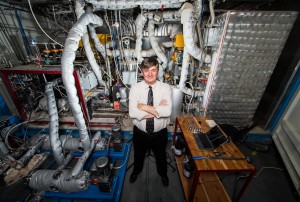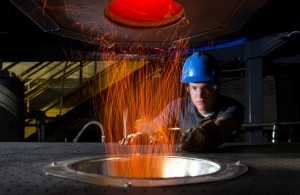
(Jaren Wilkey/BYU photo)
President Obama recently announced the Clean Power Plan, the first plan to set national standards for power plants. The plan’s goal is to reduce carbon dioxide emissions by 32 percent by the year 2030. Larry Baxter, a chemical engineering professor at BYU, is finding a way to make this reality.
Baxter has created a new technology that can potentially reduce CO2 emissions by 99 percent.
This technology is known as a cryogenic carbon-capture system. It works by freezing CO2 emissions, and separating them from other gases. This way, the CO2 won’t pollute the air. The CO2 is then pressurized into a liquid form and stored to be used later.
“This is a technology that really gauges the effects of climate change, specifically the effects of power generation on climate change,” Baxter said.
He recognized his creation may not present a complete solution to climate change.
“This technology won’t solve the whole problem of course, but it does make a major contribution towards the solution of the problem with respect to power generation,” Baxter said.
The basic idea for the system came to Baxter while on sabbatical in 2007. He had been working with people who were also interested in controlling CO2 and using the biomass for fuel. Baxter quickly patented his idea and organized Sustainable Energy Solutions, a company that has been working on developing his idea since 2008.
Christopher Russell, a doctorate candidate in chemical engineering, started working with Baxter on this technology as an undergraduate student. He said this technology will have a meaningful impact.
“There (are) a lot of things we can be doing as chemical engineers, and one of the most important ones for the rest of society is how what we do affects the environment,” Russell said. “This is going to have a very positive impact on that.”
Carbon capture technology is very rarely used; the only power plant enforcing it around the world is located in Saskatchewan, Canada.

Baxter said he has big goals for this technology in the future and would like to bring carbon capture to the U.S. He said they hope to build a commercial scale facility to run the technology in five to seven years. Baxter also mentioned that the work they have already accomplished has been very gratifying.
“Our grand goal is to change the technology on all power plants and be able to capture the pollutants from other outputs such as cars, homes and industries,” Baxter said.
Russell said he has enjoyed working on this technology.
“I feel like I’m actually a part of something that will benefit humanity,” Russell said.
Farhad Fazlollahi, a Ph.D candidate for chemical engineering at BYU, helped Baxter in developing this technology. He praised Baxter for his work.
“Everybody needs clean air and a clean environment, and Dr. Baxter is the one who showed me that we can do that,” Fazlollahi said.




